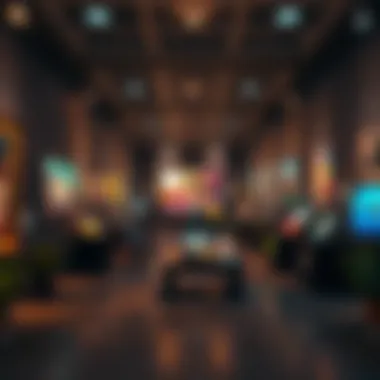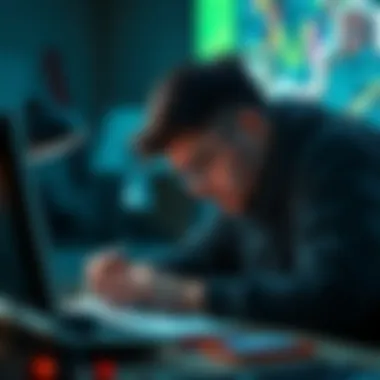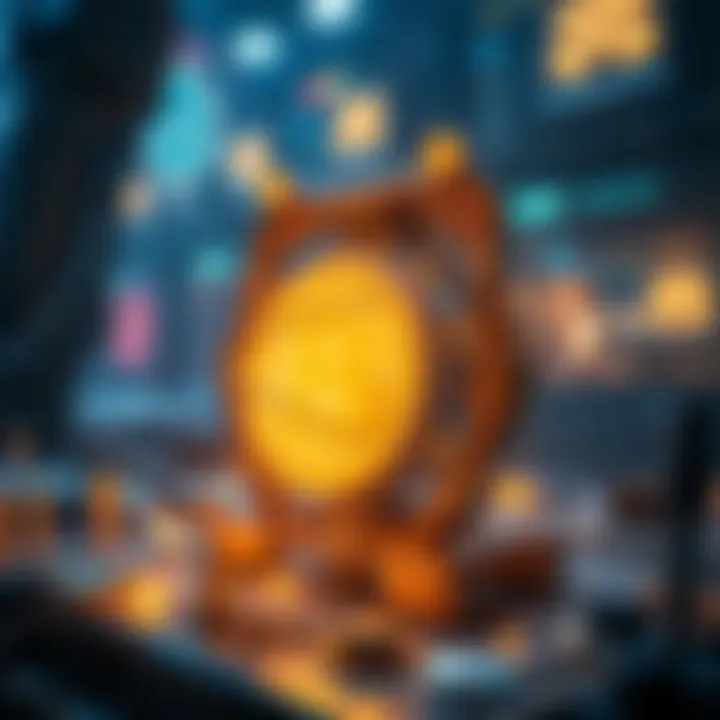Exploring the Intersection of Digital Art and NFTs


Intro
The landscape of art is experiencing a seismic shift with the rise of digital art galleries and the burgeoning arena of non-fungible tokens (NFTs). As these two phenomena converge, they redefine long-held concepts of ownership and provenance within the art world. In this discourse, we navigate through the intricacies of this evolution, exploring how NFTs serve as a cornerstone for digital ownership and the implications they present for contemporary artists and collectors.
A growing number of creators are finding new avenues for expression, showcasing their work in myriad digital galleries that have popped up across the internet. The traditional gallery model, often overshadowed by elite institutions, is being democratized. Now, artists can exhibit their works globally without geographical limitations. But how does this new age of art align with the technology behind NFTs, and what does it mean for the collectors who are eager to invest in this digital frontier? We're about to unravel these threads.
Market Trends and Analysis
Current Market Overview
As of late, the market for digital art and NFTs has exploded. Sales figures reached staggering heights as collectors recognize the intrinsic value of owning unique digital assets. High-profile auctions like those held by Christie’s and Sotheby’s have sold pieces for millions, fueling both excitement and speculation.
The appeal of NFTs stems from their ability to provide verifiable proof of ownership and authenticity, thanks to their foundation on blockchain technology. Unlike traditional art, where forgeries and provenance issues linger in play, NFTs mitigate these concerns. Artists and collectors alike take comfort in the clarity that blockchain provides, marking a new chapter in the way art is bought, sold, and shared.
"Blockchain technology alters the DNA of ownership, allowing creators to gain equitable compensation while ensuring buyers have genuine assets."
Key Influencers Affecting Prices
In this burgeoning field, several factors play significant roles in influencing the prices of digital art and NFTs. These include:
- Artist Reputation: Well-known artists often command higher prices due to their established fan bases and previous accolades.
- Rarity and Scarcity: Just like traditional art, limited edition pieces or one-of-a-kind digital artworks can fetch higher values.
- Market Dynamics: This arena is highly reactive to market demand. Fluctuating interest from major investors can impact prices rapidly.
- Celebrity Endorsements: When high-profile figures embrace certain artworks or collections, the market can see substantial price surges.
Technology and Innovation
Breakthroughs in Blockchain Technology
Technological advancements are undoubtedly at the heart of the NFT revolution. Blockchain provides a decentralized ledger system that not only verifies authenticity but also makes the transmission of ownership seamless. Every transaction involving a digital artwork creates a new entry on the blockchain, leaving a permanent and unalterable record.
NFTs offer features that push beyond mere ownership; importantly, creators can embed royalties and receive ongoing compensation whenever their work changes hands. This redefines the artist-collector relationship, ensuring that creative individuals benefit financially from future transactions.
The Role of Smart Contracts
At the core of many NFTs lies the concept of smart contracts, which are self-executing contracts with the terms directly written into code. These contracts facilitate, verify, and enforce negotiation or performance, significantly cutting down the need for middlemen in transactions. Artists can specify the conditions under which their work is sold, including royalties that they will receive each time the piece is resold. This innovative feature transforms how artists interact with their work and their audience.
As we dive deeper into this digital frontier, understanding these elements is essential for investors, analysts, entrepreneurs, and developers who seek to navigate the rapidly shifting tides of the art world.
For further reading and context on NFTs and digital art, you can explore resources such as Wikipedia and insightful discussions on Reddit to keep abreast of market developments.
Prolusion to Digital Art Galleries
When it comes to the intersection of technology and art, digital art galleries have emerged as a significant player, reshaping how art is perceived, bought, and sold. These platforms offer not just a venue for artists to showcase their work but also a means to democratize access to art, engaging global audiences in ways traditional galleries could hardly manage. The rise of digital art galleries coincides with the surging popularity of non-fungible tokens (NFTs), which have introduced a new dimension of ownership and provenance in this digital realm.
Definition and Purpose
Digital art galleries refer to online platforms that allow artists and collectors to display, share, and trade artwork in a digital format. Unlike conventional galleries, which often require physical presence, these virtual spaces remove geographical barriers, welcoming a broader spectrum of participants, from seasoned collectors to emerging artists eager to showcase their craft. The purpose is multi-fold:
- Accessibility: Offering a space where regardless of your location, you can explore diverse works from various artists
- Fair Market: Providing a level playing field for artists, who can gain visibility without the constraints placed by brick-and-mortar galleries
- Community Engagement: Fostering a sense of belonging among creators and enthusiasts, with forums for interaction and collaboration
While the concept might seem simple, its implications ripple across the entire art industry, creating new ways for valuation and appreciation.
Evolution of Art Presentation
The art world has witnessed a remarkable evolution in presentation formats, especially with the advent of digital galleries. Traditionally, art was a tangible experience—visiting galleries or museums required physical effort and time. In contrast, digital galleries leverage technology to create immersive experiences for users. As we stand on the threshold of this new era, some key shifts have emerged:
- Curatorial Approaches: With the digital medium, curators can exhibit artworks thematically rather than spatially, offering a focused narrative through the collection.
- Multimedia Elements: Artists are no longer limited to static images. Videos, animations, and interactive displays enrich the viewer's engagement, creating a responsive environment.
- Global Reach: A digital artwork can have a worldwide audience in minutes, promoting cultural exchanges that transcend regional tendencies.
"The digital art gallery is a window into the future, framed not just by walls, but by the very fabric of technology that connects us all."
In short, digital art galleries signify a leap forward in how art is consumed. An art piece can easily blend visual and auditory experiences, prompting deeper interactions. As we delve deeper into the relationship between digital art galleries and NFTs, understanding the significance of this evolution is pivotal. The next sections will explore what NFTs are and how they integrate into this dynamic landscape, further reshaping the fabric of art ownership.
Understanding NFTs
The rise of NFTs in recent years has transformed the way we perceive digital assets, particularly in the art world. Understanding NFTs is crucial as it enables stakeholders—artists, collectors, and investors alike—to navigate this new paradigm more effectively. Beyond just a trend, NFTs offer significant benefits that redefine ownership, authenticity, and value in an increasingly digital landscape.
What are Non-Fungible Tokens?
At its core, a Non-Fungible Token (NFT) is a unique digital representation of ownership, often tied to digital art, music, videos, or other creative content. Unlike cryptocurrencies such as Bitcoin or Ethereum, which are fungible and can be exchanged on a one-to-one basis with no loss of value, NFTs are distinctly individual and cannot be directly exchanged for one another.
This uniqueness means that each NFT carries specific information and details set in blockchain technology, ensuring its provenance and verifying ownership. For instance, an artist can create an NFT of their artwork, providing buyers with an indication of originality and supporting authenticity, which is something that traditional galleries have struggled with in the digital realm.


"NFTs open the door to unprecedented ways of connecting artists and collectors, allowing for true ownership in a digital format."
These tokens can represent anything from a digital painting, a tweet, or even virtual real estate in the metaverse. Their value often derives from the market demand for the item itself, the artist's reputation, and the storytelling behind the piece. \n
Blockchain Technology Explained
To fully grasp NFTs, one must have a foundational understanding of blockchain technology. At its simplest, blockchain is a decentralized ledger that records transactions across multiple computers in a way that prevents alteration. This maintenance of integrity is what underpins the security of NFTs, making them tamper-proof and verifiable.
Key characteristics of blockchain that contribute to the reliability of NFTs include:
- Decentralization: No single entity controls the blockchain, reducing the risk of fraud or manipulation.
- Transparency: Each transaction is visible in real-time, allowing anyone to track an asset's history.
- Immutability: Once a transaction is recorded, it cannot be changed, providing a permanent record of ownership and transaction history.
These features are particularly important for artists and collectors, as they can easily verify ownership and authenticity of their digital assets, which plays a significant role in determining their market value. As the world leans more towards digital solutions, understanding how blockchain works is essential for anyone involved in the art and digital asset realms.
In summary, NFTs serve as a revolutionary force within the art world by ensuring authenticity and ownership, all backed by secure blockchain technology. This blending of art and technology not only enhances roles for creators and collectors but also sets the stage for an evolving marketplace and creative expression.
The Role of NFTs in Digital Art
Non-fungible tokens, or NFTs, have become crucial players in the landscape of digital art. They act as a bridge, facilitating ownership and authenticity in a medium that has historically struggled to establish a clear chain of custody. As artists and collectors navigate this new terrain, NFTs offer both challenges and opportunities worth examining closely.
Ownership and Authenticity
At the heart of the NFT revolution is ownership—the most significant factor that separates traditional art from digital pieces. Unlike physical artworks, which often come with uncertain provenance, NFTs provide a transparent ledger that confirms who owns what. This aspect is particularly appealing to collectors who want assurance that the piece they purchase is legitimate.
The concept of authenticity in digital art can feel nebulous. However, NFTs tackle this issue head-on. Each token is unique and cannot be replicated, thanks to the underlying blockchain. When an NFT is created, it’s like assigning a serial number to a piece of art, ensuring that no two are exactly alike. This new paradigm boosts buyer confidence, allowing them to invest in digital art with the same level of trust that comes from purchasing a classic painting.
"In the digital realm, owning a piece of art can often be like owning a void. NFTs change that—providing both value and verification to digital pieces of creation."
Moreover, owning an NFT can grant access to exclusive rights or functionalities, such as royalties from future sales. This provision is a game-changer for artists, allowing them to retain a stake in their art long after the initial sale. In other words, if a piece appreciates in value, the artist can benefit from that ascent, earning a percentage each time the NFT changes hands.
Provenance and Value
The concept of provenance is not merely a buzzword; it serves a critical function in establishing the value of digital art. When collecting physical pieces, art connoisseurs often scrutinize a work's history to determine its worth. NFTs encapsulate this sort of historical branding directly within their code.
With each NFT, all relevant transaction data is stored on the blockchain, creating an indelible record of its lifespan. Buyers can trace the previous owners of the digital artwork back to its creation, leading to insights about its market value. This ability to verify an artwork's backstory can dramatically influence its desirability and price, fostering a more vibrant and stable market for both artists and collectors alike.
As this ecosystem continues to evolve, understanding these facets will be essential for investors, analysts, and entrepreneurs looking to navigate this unfolding narrative.
Digital Art Galleries: A New Paradigm
The emergence of digital art galleries signifies a transformative shift in the way art is presented, experienced, and valued in the modern age. As creativity entwines with technology, these virtual spaces are redefining traditional notions of artistic engagement. Artists and collectors alike find themselves in a dynamic marketplace influenced by digital tools and the blockchain ethos.
Digital art galleries serve multiple functions—showcasing art, providing a platform for sales, and fostering community interaction. Beyond mere exhibits, they offer artists a direct line to collectors, cutting out intermediaries that once dominated the art world. This direct-to-consumer model helps artists maintain greater control over their work and its associated value, an essential aspect in an era characterized by instant accessibility.
Case Studies of Successful Digital Galleries
Examining successful digital galleries offers insight into this new realm. Consider SuperRare, which curates high-quality digital art from established and emerging artists alike. They have created a community where exclusivity challenges the traditional openness associated with online platforms. By effective use of social networks and community involvement, they have fostered a loyal collector base willing to invest in unique digital pieces.
Another notable example is Foundation, focused on providing a space for creators to share their work without the clutter often seen in broader marketplaces. Their model facilitates an auction system that encourages competition among bidders, setting higher standards for digital artwork.
"In the digital art space, the gallery is no longer just a physical location but is rendered infinite through blockchain technology."
Features of Online Art Spaces
Diving deeper into the mechanics of these digital art galleries, several key features stand out:
- User-Friendly Interface: Online art spaces prioritize ease of navigation. A clean, intuitive design allows patrons to explore showcases and purchase artwork effortlessly.
- Interactivity: Many galleries incorporate features like virtual tours, allowing users to experience the art as if they were walking through a physical exhibit.
- Smart Contracts: Utilizing blockchain technology, transactions in digital galleries often rely on smart contracts. These contracts automate sales processes and ensure that artists receive royalties every time their work is resold in the marketplace.
- Community Engagement: A strong community aspect is vital. Galleries often host discussions, artist Q&As, and collaborations with other creatives to stimulate involvement and enhance the art-buying experience.
- Accessible Inventory: Digital galleries can host vast collections without the constraints of physical space. This democratizes art access, offering a wider range of styles and artists to a global audience.
In summary, the paradigm shift toward digital art galleries not only reflects a response to technological advancements but also marks a new standard for how art is appreciated and valued in society today. These galleries pave the way for a vibrant intersection of commerce, creativity, and community in the art world.
The Intersection of Art and Technology
Art has always had a way of adapting to the cultural and technological shifts of its time. Nowadays, we find ourselves in a digital era where technology not only influences the medium of art but also its accessibility and ownership. Digital art galleries and NFTs sit at this intersection, pushing boundaries and redefining what we consider art. The melding of traditional artistry and technology creates an outlet for innovation, leading to a vibrant new landscape that can be both exciting and overwhelming.
Key Benefits of This Intersection:
- Accessibility: Digital art can reach a global audience instantly, removing geographic barriers.
- Engagement: Technology offers creators diverse tools, promoting creativity that may not be realized through conventional means.
- New Markets: NFTs provide artists with direct access to collectors without intermediaries.
Ultimately, understanding this synergy is crucial for artists, collectors, and investors who wish to navigate this evolving environment. This understanding can lead to strategic decisions that make or break one’s journey in the art world.
Augmented and Virtual Reality Integrations


Augmented Reality (AR) and Virtual Reality (VR) have emerged as groundbreaking technologies in the art experience. These platforms allow audiences to immerse themselves in a 3D space where they can not only observe but also engage with artworks like never before.
- Enhancing Experience: Imagine standing in your living room yet walking through a virtual gallery of exclusive artworks. This level of immersion fosters a substantial connection to the art.
- New Dimensions of Creativity: Artists can create works that exist solely in these digital realms, incorporating movement, sound, and interaction into their pieces. Digital creators are no longer boxed in by the limitations of physical mediums.
Notably, museums and galleries worldwide are harnessing AR and VR to reach broader audiences. Some institutions have even implemented virtual tours, bringing their collections to anyone with internet access, bridging gaps in accessibility.
Interactive Experiences for Users
When it comes to engaging audiences, interactivity is king. Digital art galleries are transforming static viewing into dynamic experiences, allowing users to interact with art on multiple levels. This often involves:
- User Contributions: Many platforms encourage visitors to leave comments or even become part of the artwork themselves. This interaction creates a community around the art, fostering dialogue and collaboration.
- Customizable Experiences: Artists can design their works to change based on user interactions, adapting to the preferences or reactions of each viewer. For instance, an artwork might change colors or shape dynamically, depending on the viewer’s gaze or actions.
These features are not just aesthetic; they cultivate a sense of ownership and investment in the art form, making users feel more connected to the creators and each other. As a result, interactive digital experiences offer a new avenue for artistic expression while energizing audience engagement.
"The merging of technology and art has created an unprecedented opportunity for expression, connection, and innovation that challenges traditional boundaries."
In summary, the intersection of art and technology illuminates pathways for more participatory and individualized art experiences. As the landscape continues to evolve, those adopting these innovations stand to gain significant advantages in the art space.
Challenges Facing Digital Art Galleries
The digital art environment is as much a revolution as it is a marketplace painted with bright colors and staggering possibilities. Yet, with all the fanfare, there are distinct hurdles that digital art galleries must navigate in their quest for sustainability and relevance. This section explores key challenges that creators, collectors, and platforms face and sheds light on the implications of these challenges in the wider art and technology landscape.
Market Saturation
With the digital art scene booming, one pressing concern is market saturation. Many artists now choose to express themselves through digital platforms, flooding galleries with a wide variety of artworks. This was once the domain of a select few, but now it appears that everyone seems to be jumping on the digital bandwagon.
What does this mean? Too many artworks vying for attention dilutes individual pieces’ visibility and can make it harder for collectors to discover the hidden gems. The difficulty in distinguishing quality art from sheer volume can lead collectors into murky waters. In a period where countless platforms pop up almost overnight, the challenge isn't merely creating art, but also standing out amidst the chaos.
Some ramifications of market saturation include:
- Higher Competition: Artists must now find innovative marketing strategies to highlight their work.
- Quality concerns: With so much content available, some collectors may hesitate to invest in digital art, fearing it could lack long-term value.
- Eroded Prices: With galleries offering similar pieces, prices for artworks may face downward pressure, challenging artists to sustain themselves.
Cybersecurity and Fraud Concerns
In an age where digital assets are traded like hotcakes, another layer of complexity emerges: cybersecurity and fraud concerns. The burgeoning NFT space has attracted not only genuine enthusiasts but also bad actors. As transactions occur on an online basis, the risks are higher.
Digital art galleries must be vigilant and ensure their security infrastructures are on point.
Key concerns include:
- Hacking Risk: Digital wallets and platforms can be susceptible to hacking attempts, leading to significant financial losses for both artists and collectors. It’s crucial for platforms to implement robust cybersecurity measures, including the use of multi-factor authentication and regular security audits.
- Counterfeit Art: As authenticity is paramount in the art world, the potential for counterfeits remains a significant concern. Artists must ensure they have clear provenance for their work, induced perhaps by thorough documentation or third-party verification.
- Scams and Fraudulent Transactions: Unscrupulous dealings can plague new collectors entering the market. They might fall victim to fake sales or transactions without receiving the promised digital asset. Education around recognizing genuine transactions is vital for both buyers and sellers.
"As digital art becomes more popular, understanding the intricate challenges is just as important as acknowledging its groundbreaking potential."
As these challenges unfold, it becomes evident that while digital art galleries push the boundaries of creativity and interaction, they must also adeptly deal with the complexities that come along for the ride.
Legal Considerations in the NFT Space
The growing landscape of digital art galleries coupled with non-fungible tokens (NFTs) has ignited essential debates regarding the legal frameworks surrounding these innovations. As artists and collectors dive into this realm, understanding legal considerations in the NFT space offers clarity and security. Like any good investment or creative venture, navigating the legal maze can shield participants from potential pitfalls. Let's break down some core elements vital to comprehending this intricate web.
Intellectual Property Rights
In the world of NFTs, intellectual property (IP) rights are a fundamental topic. Simply put, these rights define how ownership of digital assets is perceived and enforced in a legal context. If you're an artist creating a digital masterpiece, you want to protect your creation just as much as if you had painted on a canvas. Ownership of an NFT does not automatically confer rights to the underlying artwork. This distinction can lead to confusion.
Artists need to ensure they're clearly defining the rights that accompany their NFTs. For instance, does the buyer gain exclusive reproduction rights? Can the art be used in advertisements or merchandise? Simply assuming that ownership of an NFT means full rights can lead to disputes. Educating oneself regarding IP laws and the nuances of copyright, trademark, and patent rights becomes indispensable.
- Key points to consider about IP include:
- Clear articulation of rights attached to NFTs
- Understanding copyright implications
- The need for licenses in specific use cases
With this knowledge, both artists and collectors can engage in informed commerce. As the saying goes, “A stitch in time saves nine.” Tackling these matters upfront can prevent larger headaches down the line.
Regulatory Frameworks
The regulatory landscape surrounding NFTs remains in a state of flux. Authorities across various jurisdictions are grappling with how to classify and regulate digital assets effectively. This uncertainty can cause hesitance among potential investors and creators. Are NFTs securities? Do they fall under existing laws, or do new regulations need to be constructed? The answer can vary widely depending on where you are in the world.
Countries like the United States have begun to establish clearer guidelines, but ambiguity still reigns, particularly when it comes to taxation, consumer protection, and anti-money laundering (AML) regulations. Recently, the SEC (Securities and Exchange Commission) has hinted at possible rules regarding how NFTs will be treated for regulatory purposes. Knowing your local laws is essential if you plan to mint, buy, or sell NFTs in a manner that keeps you compliant. Before jumping into the NFT scene, it’s wise to consult legal experts who are up to speed on these developments.
- Considerations in the regulatory environment involve:
- Potential classification of NFTs as securities
- Tax implications for creators and sellers
- Compliance with AML regulations


As NFTs continue to gain traction, staying informed about legal changes is crucial. The digital art space is still an uncharted territory, much like the wild west. Being proactive about legal aspects will undoubtedly foster a more sustainable participation in this evolving marketplace.
"Understanding the legal landscape is not just a precaution; it's a prerequisite for success in the NFT space."
As we unravel the threads of legality surrounding NFTs and digital art, it becomes clear that both artists and collectors face complex challenges. Equipping oneself with knowledge about intellectual property rights and regulatory frameworks creates a foundation for successful engagement in this vibrant and rapidly changing arena.
Emerging Trends in Digital Art and NFTs
The continual growth of digital art and non-fungible tokens (NFTs) has led to an evolution that's not just a fad but something profoundly reshaping the art landscape. As traditional paradigms shift, understanding these emerging trends is crucial for investors, analysts, and anyone keen on navigating this complex domain.
The Rise of Generative Art
Generative art is carving out its own niche in the digital canvas, and its rise represents a fundamental shift in how art is created and consumed. At its core, generative art involves the use of algorithms to produce unique artworks. This process not only automates the creation but also enhances creativity, allowing artists to explore styles and methods that would otherwise take years to master manually.
The beauty of generative art lies in its infinite possibilities. Artists can input parameters, and the algorithm does the rest. This creates a unique piece every time an artwork is generated. Not only does this approach democratize the art-making process, but it also cultivates an appeal to tech-savvy collectors who value innovative methods.
Some key factors include:
- Accessibility: Generative art opens the doors for more creators to enter the field without needing extensive training in traditional techniques.
- Collectability: As each piece is unique, collectors are drawn to owning something that’s one-of-a-kind, often leading to higher stakes in the auction and resale markets.
- Collaborative Opportunities: Artists can collaborate with programmers, blending creative and technical skill sets to push the boundaries of innovation.
Generative art encapsulates the spirit of adaptation and innovation by leveraging technological tools; it exemplifies how traditional art forms can meld with cutting-edge methodologies to redefine aesthetics.
Sustainability and Environmental Impact
In a world increasingly aware of climate change and ecological responsibility, the sustainability of creating and trading digital art, especially NFTs, is drawing increased scrutiny. While digital art might seem less resource-intensive than traditional forms, the environmental implications of blockchain technology cannot be overlooked.
Cryptocurrency transactions, particularly those using proof-of-work algorithms, demand a significant amount of energy. These concerns have prompted both artists and collectors to rethink how they engage with digital art. Trends worth noting include:
- Transition to Sustainable Blockchain: Alternatives like proof-of-stake or eco-friendly blockchains are emerging, offering lower-energy solutions for minting NFTs.
- Conscious Consumption: Artists may choose to release limited editions, thereby reducing the carbon footprint associated with numerous transactions. Collectors are also increasingly scrutinizing the sustainability of their purchases.
- Awareness Campaigns: Many artists are taking a stand, using their platforms to advocate for greener methods of art production and trading
The Future of Digital Art Galleries
As we steer into the uncharted waters of digital expression, the future of digital art galleries stands as a beacon for innovation and transformation. Digitization has already altered the landscape of art acquisition and appreciation, but what lies ahead can redefine the rules of engagement between artists, collectors, and audiences. Given the rapid expansion of technologies like blockchain and virtual reality, exploring this future is vital for stakeholders at every level to adapt and thrive.
When we discuss the future, several elements resonate strongly:
- Accessibility: Digital galleries can eliminate geographical barriers. An artist in a remote village can showcase their work to a global audience, providing a platform that was previously unreachable. This democratization of exposure enriches the art ecosystem.
- Interactivity: Future galleries may weave in features that allow for a two-way dialogue. Instead of just showcasing art, these spaces could incorporate mechanisms for live feedback, enabling artists to iterate and evolve their work based on audience input.
- Personalization: With algorithms analyzing user behavior, galleries will deliver tailored experiences. Imagine entering a virtual gallery that curates a selection based on your previous art tastes and purchases.
These elements, coupled with an understanding of how art intersects with advanced technologies, position digital art galleries as dynamic spaces for cultural dialogue.
"The future of art is not only about what is created; it’s about how it's experienced."
Predictions for the Art Market
The art market is on the cusp of a significant change, influenced by digital galleries. Some predictions that are already casting shadows on the contemporary scene include:
- Increased Sales through NFTs: Many predict that online galleries will increasingly utilize NFTs for sales. This will afford artists a new revenue stream while providing collectors with verified ownership and assurance of authenticity. In a world where a simple digital file can be copied endless times, NFTs introduce a layer of security that will becomes invaluable.
- Hybrid Events: The integration of virtual and physical exhibitions likely to emerge as a key trend. Artists could engage audiences from both realms, offering a simultaneous experience. This hybrid model may lead to increased foot traffic as well as web traffic, expanding the reach and appeal of art exhibits.
- Investment Opportunities: Investors are keen to explore digital artworks as alternative assets. Marketplaces centered on digital art are likely to flourish, leading to new forms of asset classes that offer provenance and value which traditional art markets have struggled to maintain.
Potential Innovations and Developments
The canvas of the future is painted with bold strokes of innovation and experimentation. Here are some potential developments:
- Augmented Reality Experiences: Imagine walking through your living room and viewing an artwork in real time. Creative integrations of AR could weave art into everyday life, allowing viewers to engage with it in unprecedented ways.
- AI-Generated Art: The advent of artificial intelligence opens doors to creating content that blends human creativity with algorithmic generation. This, not only offers fresh artistic expressions but invites heated debates on authorship and creativity which will shape the dialogue around art.
- Engagement Metrics: Future digital galleries might employ sophisticated analytics to track viewer interaction in real time. Understanding which pieces draw attention or evoke emotional responses could inform curation decisions, ensuring that galleries remain relevant to their audiences.
The pathway ahead for digital art galleries is paved with opportunities for transformation; as technological advancements rise, so too does the chance for a richer, more meaningful engagement with art. Artists and collectors alike must navigate this terrain with open minds and innovative spirits.
Ending
In this digital age, the fusion of art and technology is not just a passing trend, but a significant shift that is reshaping the entire landscape of creative expression. Understanding the interplay between digital art galleries and NFTs offers crucial insights into the future of art, ownership, and commerce. The increasing popularity of vast online platforms for showcasing digital art has catalyzed a broader recognition of artists and creators, painting a promising picture for those ready to adapt.
Summarizing Key Insights
The primary takeaways from our exploration of digital art galleries and NFTs reveal several pivotal themes. First, the concept of ownership has evolved dramatically. With blockchain technology providing irrefutable proof of ownership, artists can now assert their rights in ways previously unimaginable. Moreover, digital art galleries provide greater access, ensuring that both buyers and artists can connect without geographical limitations. Coupled with the rise of generative art and unique digital creations, artists now enjoy a platform that not only showcases their talents but can also guarantee their work's originality.
Another important aspect is the changing value perception of art. As collectors and investors consider NFTs, valuations are based more on the community's interest and the artist’s reputation than on traditional art metrics. This creates both opportunities and uncertainties for artists and audiences alike. Therefore, keeping an eye on market trends and shifts in buyer preferences has never been more critical.
"The art market is witnessing a transformation where the lines between artist and collector are increasingly blurred."
Reflections on Art in the Digital Age
In reflecting upon the future of art in this digital-first world, one can't help but acknowledge the profound implications of this evolution. Artists are no longer confined to galleries; instead, the entire Internet becomes their canvas, allowing them to interact with a global audience. This democratization of access means art can be more inclusive, less elitist, thus broadening cultural discourse.
Yet, with these advancements come challenges. As digital works proliferate, it becomes essential to navigate legal considerations and ethical questions surrounding ownership and copyright, particularly in a landscape where replication is a click away. It underscores the necessity for robust frameworks to protect creators while fostering innovation.
Ultimately, as we look back on how digital art galleries and NFTs have emerged, it is clear that we're only scratching the surface of this new artistic frontier. The conversation regarding technology's impact on creativity continues to evolve, encouraging both artists and collectors to rethink their approaches. With foresight and adaptability, stakeholders in this arena can explore new horizons where creativity flourishes in synergy with technology.
This article, with its detailed navigation through the intricacies of digital art galleries and NFTs, serves as both a guide and a call to attention for investors, entrepreneurs, and anyone engaged in this vibrant, dynamic realm of digital expression.



